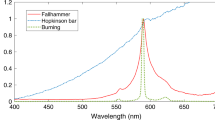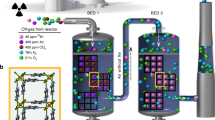Abstract
RADIOACTIVE noble gases, such as 133Xe, 135Xe, 85Kr, and 88Kr, are formed in uranium fission and are released to the atmosphere by nuclear power plants and fuel reprocessing plants. Studies of the US Public Health Service have shown that a modern boiling-water reactor, for example, releases about 20 Ci of 85Kr and 13,000 Ci of 133Xe per year under normal operating conditions1,2. Under adverse operating conditions, the release rates may be much higher1. Of the physical methods for reducing these emissions3–7, cryogenic distillation and charcoal adsorption are being developed for large-scale use.
This is a preview of subscription content, access via your institution
Access options
Subscribe to this journal
Receive 51 print issues and online access
$199.00 per year
only $3.90 per issue
Buy this article
- Purchase on Springer Link
- Instant access to full article PDF
Prices may be subject to local taxes which are calculated during checkout
Similar content being viewed by others
References
Logsden, J. E., and Chissler, R. I., Radioactive Waste Discharges to the Environment from Nuclear Power Facilities (Public Health Service, US Department of Health, Education, and Welfare, March 1970).
Lewis, W. D., et al., Engineering for Resolution of the Energy-Environment Dilemma, 68 and 192 (Committee on Power Plant Siting, National Academy of Engineering, Washington, DC, 1972).
Slansky, C. M., At. Energy Rev., 9, 423 (1971).
Knowles, D. J., and Gillespie, F. E., Nucl. Safety, 1, 47 (1960).
Keilholtz, G. W., Nucl. Safety, 8, 155 (1966).
Bendixsen, C. L., Offutt, G. F., and Wheeler, B. R., Chem. Eng., 55 (1971).
Merriman, J. R., et al., in Proc. Symp. Treatment of Airborne Radioactive Wastes, 303 (Int. At. Energy Agency, Vienna, 1968).
Bartlett, N., Proc. Chem. Soc., 218 (1962).
Claassen, H. H., Selig, H., and Malm, J. G., J. Amer. Chem. Soc., 84, 3593 (1962).
Fields, P. R., Stein, L., and Zirin, M. H., J. Amer. Chem. Soc., 84, 4164 (1962).
Chernick, C. L., et al., Science, 138, 136 (1962).
Grosse, A. V., Kirshenbaum, A. D., Streng, A. G., and Streng, L. V., Science, 139, 1047 (1963).
Pomeroy, J. H., in Noble Gas Compounds (edit. by Hyman, H. H.), 123 (University of Chicago Press, Chicago, 1963).
Slivnik, J., in Proc. of Symp. on Treatment of Airborne Radioactive Wastes, 315 (Int. At. Energy Agency, Vienna, 1968).
Stein, L., Science, 175, 1463 (1972).
Stein, L., J. Inorg. Nucl. Chem., 35, 39 (1973).
Shamir, J., and Binenboym, J., Inorg. Chim. Acta, 2, 37 (1968).
Edwards, A. J., Holloway, J. H., and Peacock, R. D., Proc. Chem. Soc., 275 (1963).
Sladky, F. O., Bulliner, P. A., and Bartlett, N., J. Chem. Soc. (A), 2179 (1969).
Baranov, G. S., Egorov, N. P., Sopikov, A. N., and Chaivanov, B. B., Zh. Fiz. Khim., 46, 18 (1972).
Selig, H., and Peacock, R. D., J. Amer. Chem. Soc., 86, 3895 (1964).
Selig, H., in Halogen Chemistry (edit. by Gutman, V.), 1, 403 (Academic Press, London and New York, 1967).
Author information
Authors and Affiliations
Rights and permissions
About this article
Cite this article
STEIN, L. Removal of Xenon and Radon from Contaminated Atmospheres with Dioxygenyl Hexafluoroantimonate, O2SbF6. Nature 243, 30–32 (1973). https://doi.org/10.1038/243030a0
Received:
Issue Date:
DOI: https://doi.org/10.1038/243030a0
This article is cited by
-
A stable argon compound
Nature (2000)
-
Reactions of oxygen and oxides of nitrogen and carbon with O2SbF6, XeFSbF6, and KrFSb2F11
Soviet Atomic Energy (1975)
-
Oxidant for Trapping Atmospheric Radiokrypton
Nature (1973)
Comments
By submitting a comment you agree to abide by our Terms and Community Guidelines. If you find something abusive or that does not comply with our terms or guidelines please flag it as inappropriate.



